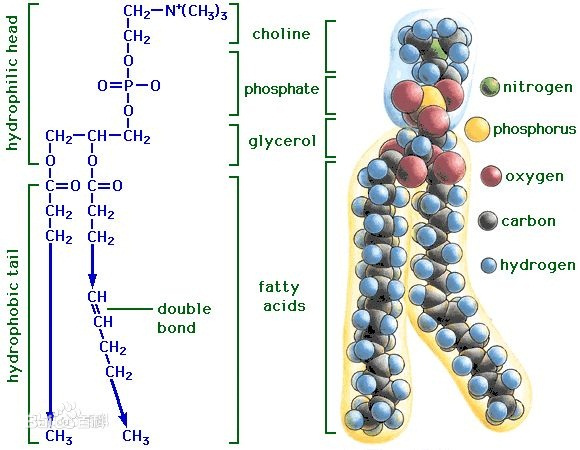
|
- Createtime: 2023-11-18
- Updatetime: 2023-11-21
Overview
Phospholipids are a class of lipids (fats) that constitute a major component of cell membranes. Their structure consists of a hydrophilic (water-attracting) head and two hydrophobic (water-repelling) tails. The hydrophilic head contains a phosphate group, making it polar and interacting well with water. The hydrophobic tails, usually composed of fatty acid chains, repel water but interact with other hydrophobic molecules.
Phospholipids play a crucial role in cellular processes, including cell signaling, transmembrane transport of molecules, and providing structural integrity to cell membranes. Additionally, phospholipids are involved in the formation of lipoproteins that transport lipids in the bloodstream.
Sources
Soybean: Soybean lecithin, especially phosphatidylcholine, is an abundant source of phospholipids. Lecithin is extracted from soybean oil and used in various food and industrial applications.
Egg Yolk: Egg yolk contains phospholipids, particularly phosphatidylcholine. Lecithin extracted from egg yolk is used in food and as a dietary supplement.
Sunflower Seeds: Sunflower seed lecithin serves as another source of phospholipids, similar to soybean lecithin, and is often used in the food industry.
Krill Oil: Krill oil contains phospholipids, including phosphatidylcholine, derived from tiny shrimp-like crustaceans called krill. Krill oil is primarily used as a dietary supplement.
Fish: Some fish, especially cold-water fish like salmon, mackerel, and sardines, contain phospholipids. Fish oil supplements provide phospholipids and omega-3 fatty acids.
Organ Meats: Animal organs such as the liver contain phospholipids, with the content varying by specific organ.
Synthetic Production: Phospholipids can be synthesized in laboratories for research, pharmaceutical, and certain industrial applications.
Microorganisms: Some microorganisms, including bacteria and fungi, can produce phospholipids, and these microbial-derived phospholipids find applications in various industries.
Applications
1.Cell Membrane Structure and Function:
Phospholipids are fundamental for cell membrane formation, providing structural integrity and a semi-permeable barrier for molecular control.
2.Emulsification and Solubility:
Phospholipids possess emulsifying properties, aiding in the dispersion of fats in water. This property is utilized in the food industry for products like mayonnaise and salad dressings.
3.Drug Delivery Systems:
Phospholipids are used in the development of lipid-based drug delivery systems, enhancing the solubility and bioavailability of poorly soluble drugs and improving targeted drug delivery.
4.Nutrient Transport:
Phospholipids, especially phosphatidylcholine, participate in the transport of lipids and fat-soluble vitamins in the bloodstream as part of lipoproteins.
5.Brain Health and Cognitive Function:
Phosphatidylserine, a type of phospholipid, is believed to have positive effects on cognitive function and memory, used as a dietary supplement for brain health.
6.Digestive System Health:
Phospholipids can promote bile formation, aiding in the digestion and absorption of dietary fats in the intestines.
7.Cosmetic and Skincare Products:
Phospholipids are used in cosmetics and skincare products for their moisturizing and emollient properties, improving product texture on the skin.
8.Biotechnological and Pharmaceutical Applications:
Phospholipids play a role in the formulation of pharmaceuticals and biotechnological products, used in liposomal drug delivery systems, vaccines, and other therapeutic applications.
9.Food Industry Applications:
Phospholipids are employed in the food industry as emulsifiers, stabilizers, and texture enhancers, contributing to the texture and mouthfeel of various food products.
10.Agricultural and Animal Feed:
Phospholipids may be used in animal feed to improve nutrient absorption and overall animal health, also used to mitigate the negative effects of mycotoxins in feed.


 CN
CN




